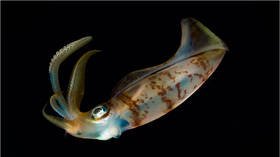The invisible man? Scientists engineer human cells to become TRANSPARENT like squids

In a remarkable first, researchers have successfully transferred the natural camouflage ability often displayed by some species of squid and cuttlefish into human cells, allowing them to bend light.
Certain species of octopus, squid and other sea creatures have specialized tissues in their bodies which allow them to manipulate light and seamlessly blend in with their surroundings to confuse predators, or surprise prey.
Now researchers at the University of California have engineered human cells to have similar camouflage capabilities to those seen in cephalopod skin. While it sounds like the plot of a comic book or a science fiction film, the UCI researchers assure people that this is, in fact, hard science.
"Our project – which is decidedly in the realm of science – centers on designing and engineering cellular systems and tissues with controllable properties for transmitting, reflecting and absorbing light," says lead author Atrouli Chatterjee, a UCI doctoral student in chemical and biomolecular engineering.
Also on rt.com Scientists unlock secrets of 3D ‘invisibility cloak’ using… cuttlefish? (VIDEO)Chatterjee works in the laboratory of Alon Gorodetsky, an associate professor of chemical and biomolecular engineering, whose teams have previously made breakthroughs in infrared camouflage and other high tech materials.
Chatterjee drew inspiration from the female Doryteuthis opalescens squid, which can switch the stripe on its mantle from almost transparent to opaque white as a defence mechanism, using certain kinds of proteins called reflectins.
The team took some of the protein-based particles behind this “biological cloaking technique” to recreate the amazing ability in human cells.
"We were amazed to find that the cells not only expressed reflectin but also packaged the protein in spheroidal nanostructures and distributed them throughout the cells' bodies," said Gorodetsky, who co-authored of the study, adding that the cells behaved almost exactly as they do in squids.
Also on rt.com Monstrous giant squid discovered on New Zealand beach (PHOTOS)The team also tested whether they could turn the ability on or off using external stimuli by placing the cells between two plates of glass coated with different concentrations of salt.
The “cloaking cells” exposed to more sodium chloride scattered more light and stood out more from their surroundings.
For now, however, the breakthrough is restricted to medical and biological microscopy applications, so we likely won’t be chasing invisible men down the street any time soon.
Think your friends would be interested? Share this story!
















